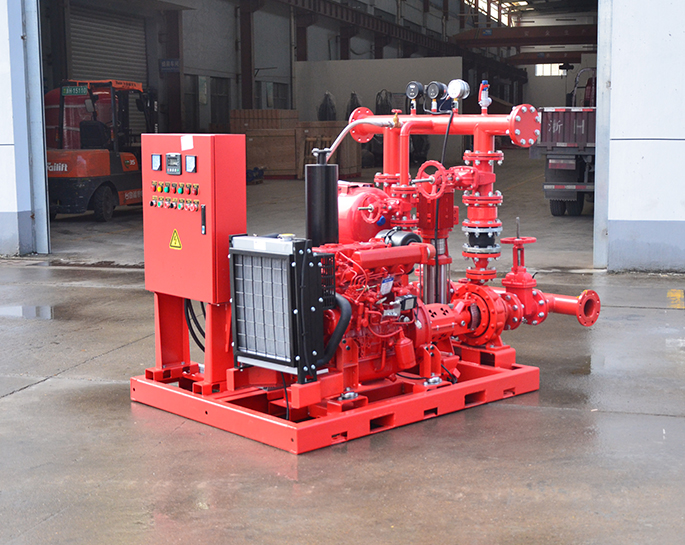What role does proper alignment play in the maintenance of fire pump systems?
Jan 30, 2024
Share:
Proper alignment is crucial for the effective and reliable operation of fire pump systems. Fire pump systems are critical components in fire protection systems, designed to provide water at a sufficient pressure to suppress or control a fire. Proper alignment plays a key role in ensuring the optimal performance, longevity, and safety of these systems. Here are some reasons why alignment is important in the maintenance of fire pump systems:
1. **Efficiency and Performance:** Correct alignment ensures that the pump components, such as the shaft, impeller, and bearings, are properly positioned and oriented. This results in smooth operation, minimizing friction and wear, and maximizing the efficiency of the pump. Efficient pumps deliver the required water flow and pressure more effectively during a fire emergency.
2. **Reduced Wear and Tear:** Misalignment can lead to excessive wear and tear on pump components, including the shaft, bearings, and seals. Proper alignment helps distribute loads evenly, reducing the likelihood of premature failure and the need for frequent repairs or replacements.
3. **Energy Efficiency:** Misalignment can increase the energy consumption of the pump, as it may require more power to overcome resistance and operate. Proper alignment ensures that the pump operates at its designed efficiency, minimizing energy waste and reducing operational costs.
4. **Vibration and Noise Control:** Misalignment can cause excessive vibration and noise, which not only contributes to wear and tear but also creates an undesirable working environment. Proper alignment helps control vibration and noise levels, promoting a quieter and more stable operation.
5. **Reliability and Safety:** Fire pump systems are critical for life safety in emergency situations. Reliable operation is essential to ensure that the system functions as intended during a fire event. Proper alignment contributes to the overall reliability of the system, reducing the risk of unexpected failures and ensuring that the fire pump is ready to perform when needed.
6. **Compliance with Standards:** Fire pump systems must comply with industry standards and regulations to ensure their effectiveness. Proper alignment is often a requirement specified in these standards. Regular alignment checks and adjustments help maintain compliance with relevant codes and standards.
In summary, proper alignment in fire pump systems is vital for ensuring efficiency, reliability, and safety. Regular maintenance, including alignment checks, should be part of a comprehensive fire protection strategy to ensure that these systems operate effectively in emergency situations.

1. **Efficiency and Performance:** Correct alignment ensures that the pump components, such as the shaft, impeller, and bearings, are properly positioned and oriented. This results in smooth operation, minimizing friction and wear, and maximizing the efficiency of the pump. Efficient pumps deliver the required water flow and pressure more effectively during a fire emergency.
2. **Reduced Wear and Tear:** Misalignment can lead to excessive wear and tear on pump components, including the shaft, bearings, and seals. Proper alignment helps distribute loads evenly, reducing the likelihood of premature failure and the need for frequent repairs or replacements.
3. **Energy Efficiency:** Misalignment can increase the energy consumption of the pump, as it may require more power to overcome resistance and operate. Proper alignment ensures that the pump operates at its designed efficiency, minimizing energy waste and reducing operational costs.
4. **Vibration and Noise Control:** Misalignment can cause excessive vibration and noise, which not only contributes to wear and tear but also creates an undesirable working environment. Proper alignment helps control vibration and noise levels, promoting a quieter and more stable operation.
5. **Reliability and Safety:** Fire pump systems are critical for life safety in emergency situations. Reliable operation is essential to ensure that the system functions as intended during a fire event. Proper alignment contributes to the overall reliability of the system, reducing the risk of unexpected failures and ensuring that the fire pump is ready to perform when needed.
6. **Compliance with Standards:** Fire pump systems must comply with industry standards and regulations to ensure their effectiveness. Proper alignment is often a requirement specified in these standards. Regular alignment checks and adjustments help maintain compliance with relevant codes and standards.
In summary, proper alignment in fire pump systems is vital for ensuring efficiency, reliability, and safety. Regular maintenance, including alignment checks, should be part of a comprehensive fire protection strategy to ensure that these systems operate effectively in emergency situations.







